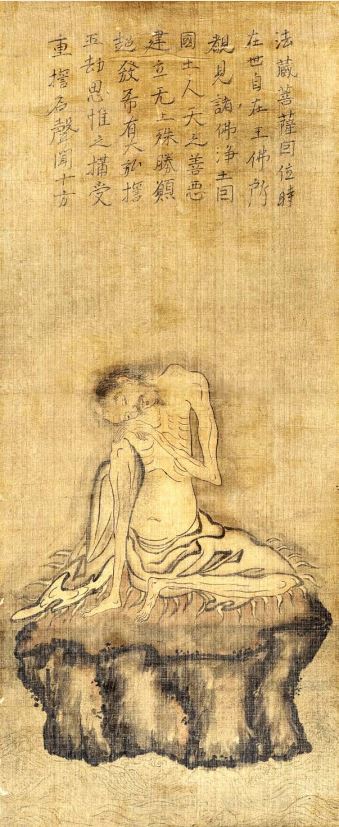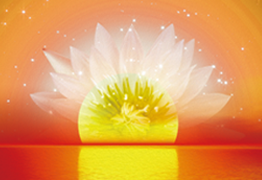Light Dispelling Darkness: Five Eons of Contemplation by Dharmakara Bodhisattva
By Master Jingkai
Amituofo is the sanctuary for all sentient beings. Before he attained Buddhahood, he was Dharmakara Bodhisattva, engaged in cultivation on his causal ground. It was an era both exceedingly challenging and magnificent. The painting we observe here portrays that historical period of the Bodhisattva. Rendered in light ink on silk, its exact dimensions are not specified. On the upper part of the artwork, an eight-line inscription reveals profound insight:
When Dharmakara Bodhisattva was on his causal ground,
At the abode of Buddha Lokesvararaja, he sought guidance,
Discerning the causes of practices leading to Buddha Lands,
And the goodness and evil of the celestial and human beings on those lands,
Pledging lofty and supreme vows to embrace,
The fundamental, extraordinary vow of compassion he did trace.
For five eons, he contemplated the means to liberate with grace,
His fame thus spread, transcending every place.
A significant expanse of the silk canvas was intentionally left untouched, allowing the subdued ink wash and spontaneous brushwork to fill the scene with dense clouds and mists, which obscure the distinction between sky and earth. Behind the misty veil, one might expect to find infinite depth and vastness, yet no mountains or forests come into view. The atmosphere is enveloped in a hazy melancholy, reminiscent of a dark night, but it also carries the promise of dawn’s first rays, revealing a solitary island surrounded by an immense ocean.
The interplay between the emptiness of the blank space, the vast sea, and the isolated island offers a profound metaphor. The painting captures the meticulous, expansive, and unrivaled portrayal of a singular figure, Dharmakara Bodhisattva, along with the depth of his contemplation and aspiration. In the void, there exists countless lands that the brush has left unexpressed. The artist cleverly uses the interspersed misty clouds to suggest a backdrop for the Bodhisattva’s profound contemplation.
Beneath his feet, white waves surge and break, each bearing the weight of deep thoughts and lofty aspirations. The Bodhisattva’s contemplation is mirrored in the intricate pattern of delicate ripples - rising and falling, unfolding and weaving through complex twists and turns. The majestic boulder that rises from the water, standing resolute, symbolizes the culmination of the virtues of all pure lands, its merits eclipsing those of all Buddhas.
At that time, Dharmakara Bodhisattva’s heart was brimming with visions of the countless lands that span the ten directions. His thoughts rose and fell with the ferocity of relentless waves. Day and night, he immersed himself in profound contemplation. The anguished cries of sentient beings in the Saha world filled his ears without pause, constantly reminding him of their suffering. This unending sound of sorrow drove him to devise a revolutionary path to salvation - one that would offer liberation to those beyond the aid of all other Buddhas, extending compassionate rescue to those whom the other Buddhas had reluctantly forsaken.
One may wonder about the mental toll of such contemplation. To understand, consider the demeanor of Dharmakara Bodhisattva.


The painting of Five Eons of Contemplation
(by Dharmamakara Bodhisattva)
.jpg)
Detail of "Dharmakara Bodhisattva's Five Eons of Contemplation"
Seated on a cushion of lemongrass, he unfolded one leg from his meditative pose and placed one hand over the other, gently supporting the side of his cheek as if to ease the weight of his profound reflections. Perhaps the intensity of his deliberation called for a brief respite, prompting this shift in posture. His frame was stooped, his eyes half-open, and he wore an expression of faint ease. At first glance, with his protruding bones, unkempt hair and beard, and a thinning crown, he could almost be mistaken for Prince Siddhartha amidst his ascetic practices in the mountains.
Yet, what the artist portrays is Dharmakara Bodhisattva, whose emaciation reflects that of Prince Siddhartha with an added distortion. The torso and limbs are exaggeratedly stretched, and the lines are drawn so freely and without restraint that they border on being rough and scribbled, eschewing any adherence to realistic human proportions.
The painter chose such an unconventional representation because Amituofo, known as the King among Buddhas, manifested in the West with a divine form that defies imagination. Such an inconceivable Buddha body must arise from unfathomable aspiration and cultivation during his formative time in the causal ground. Therefore, an extraordinary style of painting is required to capture it.
Dharmakara Bodhisattva devoted five eons to studying, understanding and embodying the compassionate practices of other Buddhas in order to formulate a skilful means of liberating sentient beings. This period is referred to as the “Five Eons of Contemplating the Salvation Path.” As a Bodhisattva, he accumulated the vast compassion of countless others on their paths, the magnitude of which is too great for any ordinary human form to grasp. Yet, he was there to endure the unendurable, challenging conventional understanding.
It seems beyond belief that Dharmakara Bodhisattva could manifest the intense compassion of numerous Bodhisattvas within a conventional human form but, astoundedly, this is precisely what he did. This indicates that he possessed an extraordinary and compelling life force. Physically, he had a distinctive stature that separates him from others; spiritually, he was endowed with such exceptional talent, bravery, and wisdom that surpass ordinary human capacity. If the artist had attempted to convey the nature of the Bodhisattva by merely depicting his external form, the effort would have fallen short. It required a bold and imaginative approach, with unconventional brushwork, to truly represent the remarkable and singular spirit of Dharmakara Bodhisattva.
The Sutra of the Infinite Life tells us that eons ago, countless Buddhas emerged in the world one after another, and then entered into Nirvana once their teachings were established. Despite their efforts, we, the afflicted beings, remain ensnared in the miserable realms of asuras, animals, ghosts and hells, out of reach from enlightenment, continuing our struggle within the cycle of birth and death.
Those countless Buddhas came and went, bringing fleeting light to the world, and left us once again fumbling blindly in darkness. We are forever caught in the endless cycle of samsara. How do we break free? Fortunately, we encountered the supreme Dharma. Yet, all too often, we talk the talk but don’t walk the walk - our practices fall short of completion. Given this, do we truly deserve to yearn for a life filled with joy and peace?
Indeed, we don’t deserve it, and Dharmakara Bodhisattva had long pondered over this with a heavy heart. Thankfully, the glow of the Buddhas cast its light upon the solitary rock amidst the ocean’s expanse, unveiling the raw devotion of the lone figure on the rock. Embraced by a state of sublime solitude, undisturbed by external and internal turmoil, Dharmakara Bodhisattva tirelessly explored the mental and physical landscapes of suffering - be they in hell, the animal realm, or the realm of hungry ghosts. His unwavering quest was for the sweet dew of enlightenment for all sentient beings.
During those five eons, there were Bodhisattvas who made their compassionate vows, cultivated virtue, and diligently worked to guide sentient beings to enlightenment. Yet Dharmakara Bodhisattva was still in deep meditation, contemplating over the two hundred and ten billion Buddha-lands. He was pondering which realm was pure bliss without suffering, which was accessible for rebirth, and which could mend the brokenness and flaws of the Saha world. Driven by this reflection, he made the Forty-Eight Vows, with each vow re-stating the following:
If, when I attain Buddhahood, sentient beings of the ten directions,
Who desire to be born in my land, and recite my name down to ten times,
Should they fail to be born there, may I not attain perfect enlightenment.
He proclaimed, “No matter what, I will save them! No matter what, I will save them!”
Across the vastness of space, a chorus of acclamation thundered through the universe: “He will assuredly attain perfect enlightenment!”
It was a vow endorsed by all Buddhas and longed for by all sentient beings, making his five eons of solitary contemplation a shared journey. We are so fortunate that Dharmakara attained the perfect enlightenment and is now a Buddha, in the Western Pure Land. He is named “Namo Amituofo.” Reciting Namo Amituofo will assure us to be reborn in his land and become a Buddha.
From now on, the boundless darkness has been dispelled, and the glow of dawn is upon us.
(Translated by the Pure Land School Translation Team;
edited by Householder Fojin)
Characteristics
- Recitation of Amitabha’s name, relying on his Fundamental Vow (the 18th)
- Rebirth of ordinary beings in the Pure Land’s Realm of Rewards
- Rebirth assured in the present lifetime
- Non-retrogression achieved in this lifetime

The 18th Vow of Amitabha Buddha
If, when I achieve Buddhahood, sentient beings of the ten directions who sincerely and joyfully entrust themselves to me, wish to be reborn in my land and recite my name, even ten times, should fail to be born there, may I not attain perfect enlightenment. Excepted are those who commit the five gravest transgressions or slander the correct Dharma.
Guiding Principles
Faith in, and acceptance of, Amitabha’s deliverance
Single-minded recitation of Amitabha’s name
Aspiration to rebirth in Amitabha’s Pure Land
Comprehensive deliverance of all sentient beings
